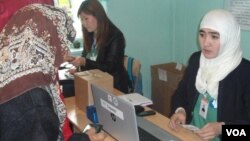October 4th marked another milestone in the Kyrgyz Republic’s democratic development since its first peaceful transfer of Presidential power with the election of President Almazbek Atambaev in 2011. Parliamentary elections in October 2010 and the subsequent presidential election in October 2011 set the Kyrgyz Republic on the path to representative government.
Five years later, on October 4, nearly 60 percent of registered voters turned out to vote in parliamentary elections featuring 14 political parties competing for all 120 seats in the Jogorku Kenesh, as the parliament is known in Kyrgyz. The vote has particular significance, since Kyrgyzstan has a parliamentary system of government and a unicameral legislature.
The United States congratulates the people of the Kyrgyz Republic for exercising their democratic rights during these elections. President Atambaev, the Jogorku Kenesh, the Central Election Commission, and many governmental and civil society groups contributed to an election that advanced the democratic process in the Kyrgyz Republic.
The Kyrgyz authorities worked assiduously to introduce biometric voter identification electronic vote counting technology, to help combat some of the irregularities which occurred in previous elections.
The Organization for Security and Cooperation in Europe (OSCE) Office of Democratic Institutions and Human Rights (ODIHR) observation mission and the Coalition for Democracy and Civil Society, a highly respected local NGO, noted in their preliminary reports that the election process was competitive and provided voters with a wide range of choice.
Moreover, the government’s introduction of new voting technologies demonstrated its commitment to improving the election process, and appears to have been successful in curtailing abuses of the past.
Democracy is as much a process as a destination, and the OSCE/ODIHR observation mission noted concerns to take into account for future elections about the inclusiveness of the voter list, ballot secrecy, vote counting procedures and the availability of impartial information. While more work remains to be done for future elections, these elections are an important step toward consolidating Kyrgyzstan’s democratic development and should be a point of pride for the Kyrgyz people.














